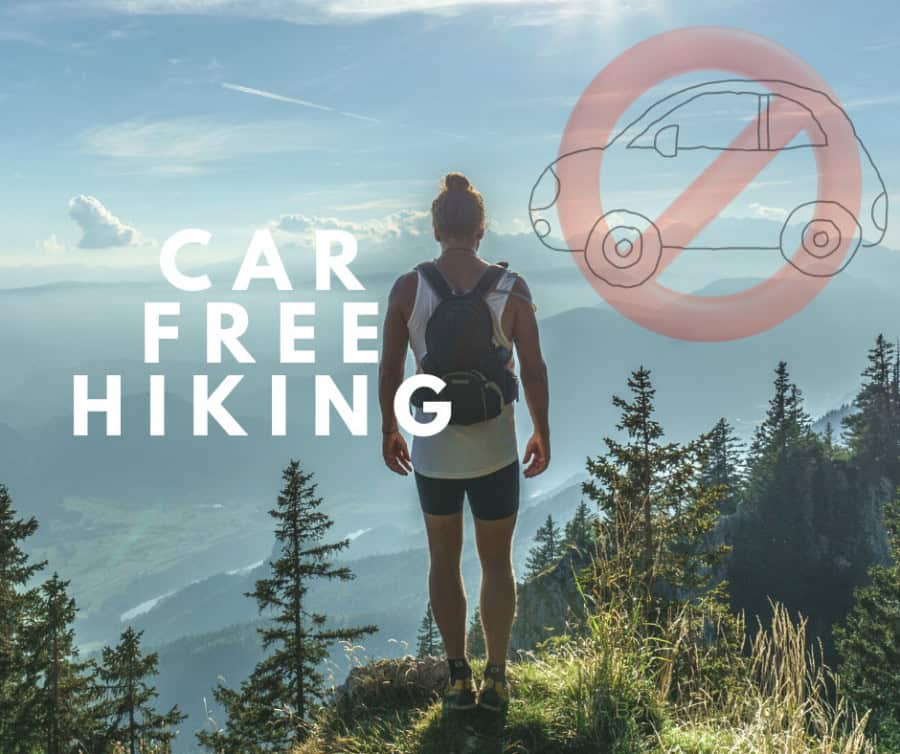Table of Contents
Some links on posts are affiliate links and will earn us a commission from qualifying purchases
Picture this: you’ve just completed a glorious 10-mile hike, you’re feeling euphoric, boots satisfyingly muddy, and you wander into the village only to discover… you missed the last bus by three minutes. The next one? Tomorrow morning. Congratulations – you’ve just unlocked the “car-free hiking experience.”
Car-free hiking in the UK is brilliant in theory, slightly maddening in practice – but, with a little preparation (and a bit of good humour), it can actually be one of the most rewarding ways to explore the countryside.
Why car-free hiking is appealing – sustainability and freedom
Let’s be honest, not everyone has access to a car, and even if you do, sometimes you just don’t want the hassle of driving, parking, and inevitably forgetting where you left the car. Going car-free is better for the planet, saves money on petrol, and adds a sense of adventure – there’s something satisfying about stepping off a train, walking all day, and ending somewhere completely new.
It also gives you freedom: point-to-point walks become possible, so you don’t have to loop back to where you started. Plus, it’s great for those pub walks where a celebratory pint at the end won’t leave you worrying about driving home.
The reality – limited services, delays, poor connections
Here’s the rub: rural public transport isn’t exactly known for its reliability. Buses might run twice a day, if you’re lucky. Trains may leave once every two hours, with the last one frustratingly early. And when there are engineering works, rail replacement buses, or random cancellations, your perfectly crafted plan can fall apart faster than you can say “signal failure at Clapham Junction.”
Then there’s the timetable issue – the bus you need from the station may leave three minutes before your train arrives. Or the return bus doesn’t run on Sundays. Or the ticket machine at the station is broken and the guard isn’t in a selling mood. In short: car-free hiking adds a layer of logistical puzzle-solving to your day.
Planning tools – apps, timetables, real-time updates
Planning is everything. The more you know, the smoother the day. My go-to tools for car-free hiking include:
- Trainline app – easy way to check times and buy tickets, but also shows which trains are running late (which is… often).
- National Rail Enquiries – the gold standard for real-time train info.
- Google Maps / Transit – great for figuring out connections, though occasionally over-optimistic about how far you can walk in five minutes.
- Bustimes.org – yes, this website looks like it was built in 2004, but it’s brilliant for showing live bus tracking across the UK.
- Komoot or OS Maps app – perfect for plotting walks between stations or bus stops.
Always screenshot or download timetables in case you lose signal, because nothing says “fun” like being stranded in a valley with 1% battery and no idea when the next bus is coming.
Backup plans – taxis, hitchhiking etiquette, overnight options
Sometimes, despite your best planning, you will miss the bus. Or the bus simply won’t turn up. At this point, it’s time to invoke the backup plan:
- Taxis – research local numbers before you set out. Rural taxis aren’t like city ones; they may need booking hours in advance.
- Hitchhiking – still a thing in rural areas! If you try it, smile, look non-threatening, and hold a polite sign with your destination. And yes, take normal safety precautions.
- Overnight stays – occasionally, the best solution is to shrug, find a B&B, and turn your day hike into a micro-adventure. Bonus points if there’s a good pub nearby.
When I have been walking the South Downs with my daughter I always plan a B&B as I’m never sure whether one of us will be slower than the other, or if we have to take a slight diversion to avoid some cows (we always seem to find them blocking our exits from fields!
Best regions for car-free hiking
Some parts of the UK are genuinely brilliant for public-transport hiking:
- Snowdonia – the Sherpa’r Wyddfa bus network links up popular valleys, and the trains along the Cambrian Coast and Conwy Valley give great access points.
- Lake District – trains to Windermere, Penrith, Oxenholme, then buses to Ambleside, Keswick, and beyond. Summer has better frequency – check timetables.
- Peak District – probably the easiest of all. Regular trains from Manchester and Sheffield get you right into Edale, Hope, and other walking hubs. Perfect for a day hike straight off the platform.
These areas have enough infrastructure that you can plan a linear route and get back without feeling like you’re taking part in a reality-TV survival challenge.
Example Car-Free Day Hikes
- Snowdonia
- Betws-y-Coed to Capel Curig – a classic riverside and forest walk, start at Betws-y-Coed station and finish where the Sherpa bus can bring you back.
- Llanberis Path up Snowdon – take the train or bus to Llanberis, walk up and down, then grab the Sherpa bus back to your start point if needed.
- Barmouth to Fairbourne – coastal estuary walk, with the bonus of the old wooden railway bridge (and train back from Fairbourne).
- Lake District
- Windermere to Ambleside – start from Windermere station, walk through Troutbeck and along the fells, then catch a bus back to Windermere.
- Keswick to Threlkeld – the converted railway path is flat, scenic, and ends at a village pub; buses run regularly back to Keswick.
- Grasmere to Rydal – a short but gorgeous loop, and you can catch buses at either end if needed.
- Peak District
- Edale to Hope – start at Edale station, go over Hollins Cross with epic views of Mam Tor, then descend into Hope for a train back.
- Hathersage to Bamford – a gentle valley walk, both have train stations on the Hope Valley Line.
- Derwent Edge Circular – take the bus to Fairholmes Visitor Centre, do the circuit, then catch the return bus – or keep walking and end at Bamford station.
Conclusion – worth the hassle, with preparation
Car-free hiking might occasionally test your patience (and your ability to run for a bus in hiking boots), but it’s also one of the most rewarding ways to experience the UK countryside. It feels more adventurous, more flexible, and definitely more eco-friendly.
With good planning, backup options, and a willingness to laugh when things go wrong, you’ll find yourself doing more car-free hikes – even if you have a car sitting at home. After all, there’s nothing quite like that moment when you collapse into your train seat, boots muddy, rucksack full of crumbs, and watch the countryside roll by while someone else does the driving.
Recent Posts
What Is the Slow Ways Movement and Why It Matters for UK Walkers in 2025
Walking has always been part of everyday life in Britain, but the Slow Ways movement is helping to reshape how people think about getting around on foot. If you enjoy walking for fitness, wellbeing...
Hiking in the UK is more popular than ever in 2025. People are heading outdoors in record numbers, not only to the mountains and national parks but also into their own towns and cities. Rural hiking...


